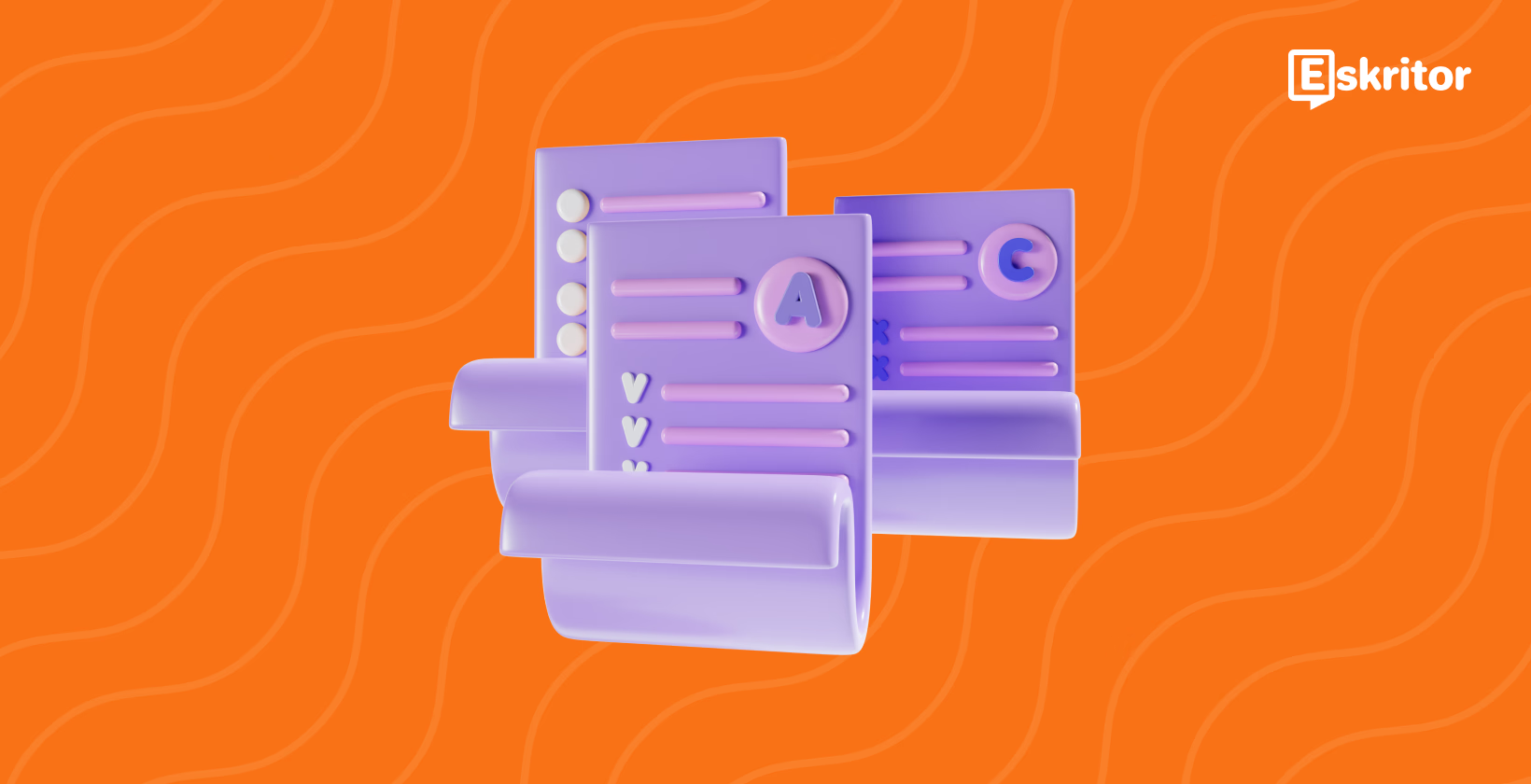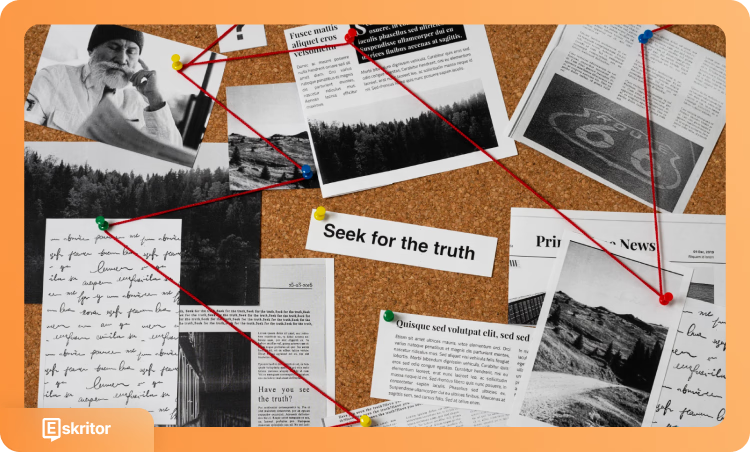
5 Main Types of Essays
Generate the Best Content with AI in Seconds
Generate the Best Content with AI in Seconds
Quick Answer: The five main essay types are descriptive essay, narrative essay, expository essay, persuasive essay, and argumentative essay.
Where to Use Each Type of Essay: Each type of essay serves a specific purpose in academic writing, and choosing the right essay type depends on your assignment goals. Use descriptive essays to paint a picture, narrative essays to tell a story, expository essays to explain concepts, persuasive essays to convince readers, and argumentative essays to present balanced debates.
Why the Types of Essays are Important: Research from BMC Medical Education shows that in a study of 139 medical students, those who learned through structured writing scored significantly higher on knowledge transfer tests (7.97 points vs 4.09 points for self-study students - a 95% improvement).
The following is a brief list of the five main types of essays, along with their key features.
- Descriptive Essay: Uses sensory language to describe a person, place, object, or experience.
- Narrative Essay: Tells a story with a clear sequence, characters, and plot.
- Expository Essay: Explains or informs using logical structure and factual support.
- Persuasive Essay: Convinces the reader to adopt a particular viewpoint using emotional and logical appeals.
- Argumentative Essay: Presents a balanced analysis of an issue, then supports one side with structured reasoning.
For detailed learning about the five main types of essays, check the following sections for descriptive essay, narrative essay, expository essay, persuasive essay, and argumentative essay.
1. Descriptive Essays

A descriptive essay is a type of academic writing that presents detailed observations to help the reader visualize a subject through sensory information.
Writers use descriptive essays to depict objects, places, events, or people with vivid, specific details. These essays rely heavily on language that appeals to the senses, sight, sound, touch, taste, and smell, to construct a strong image in the reader’s mind. Unlike narrative essays that follow a storyline, descriptive writing focuses on static impressions and atmosphere without a plot or sequence of events.
When to Use a Descriptive Essay: Use a descriptive essay when the goal is to illustrate something in detail rather than explain, argue, or tell a story. This format suits personal reflections, artistic descriptions, and creative assignments where evoking a mental picture is essential. Academic tasks may include describing a historical site, a scientific observation, or a visual analysis.
The following are the key characteristics of descriptive essays.
- Sensory language targeting all five senses
- Concrete and specific details over generalizations
- Dominant impression or mood
- Spatial or logical organization of content
- No argumentative or explanatory purpose
Common Mistakes in Descriptive Essays: Writers often overload descriptive essays with unnecessary adjectives or irrelevant details. Repetition, vague wording, and lack of structure reduce clarity. Another issue is shifting into narrative or argumentative modes, which weakens the purpose of pure description.
Example of a Descriptive Essay:
“Title: The Campus Library as a Study Environment
Introduction The campus library provides an environment specifically designed to support focused academic work. This essay describes its spatial layout, sensory atmosphere, and functional features to demonstrate why it is conducive to effective study.
Body Paragraph 1: Physical Layout "The library is divided into three floors, each designated for a different study function." "Group study rooms with movable chairs occupy the ground level." "Individual carrels on the top floor create enclosed, distraction-free spaces."
Body Paragraph 2: Sensory Conditions "The lighting is bright but diffused, minimizing glare on screens." "Footsteps are muffled by dense carpeting, and signage reminds users to remain silent." "A consistent indoor temperature supports prolonged concentration."
Body Paragraph 3: Functional Features "Every table includes built-in outlets and reading lamps." "Students can borrow noise-canceling headphones from the circulation desk." "Printer stations and digital catalogs reduce interruptions during research."
Conclusion By describing layout, sensory settings, and available tools, this essay shows how the campus library is intentionally structured for academic focus. Its features reflect the practical requirements of sustained, undisturbed study.”
2. Narrative Essay

A narrative essay is a type of academic writing that presents a structured account of a personal or fictional event, organized around characters, setting, and plot.
Writers use narrative essays to tell real or imagined stories with a clear beginning, middle, and end. This format focuses on sequence and reflection rather than analysis or persuasion. Narrative writing may include first-person perspective, descriptive elements, and emotional insight, but it remains structured with a central theme or lesson.
When to Use a Narrative Essay: Use a narrative essay when the assignment calls for storytelling, reflection, or recounting personal experiences. This form is common in personal statements, literacy narratives, or reflective journals, where the goal is to demonstrate understanding or insight through a personal lens.
The following are the key characteristics of narrative essays.
- Chronological or purposeful time-based structure
- Clear introduction, conflict, climax, and resolution
- First-person or third-person point of view
- Character and setting development
- Theme or underlying message
Common Mistakes in Narrative Essays: Writers often treat narrative essays as informal storytelling. This leads to weak structure, lack of reflection, or unfocused content. Overusing dialogue, missing a clear point, or skipping transitional events can undermine coherence. Maintaining academic tone and structure is essential even in personal narratives.
Example of a Narrative Essay:
“Title: Learning to Manage Time During My First Semester
Introduction "During my first semester of university, I struggled to manage academic deadlines and personal responsibilities."
Body Paragraph 1: Background and Conflict "I signed up for five courses, worked part-time, and underestimated the time needed for assignments." "By midterm, I had missed two paper deadlines and failed a quiz."
Body Paragraph 2: Turning Point "After meeting with my academic advisor, I created a weekly study schedule." "I started blocking hours for reading, writing, and reviewing instead of cramming."
Body Paragraph 3: Resolution and Reflection "By the final exam period, I had submitted every assignment on time and passed all courses." "This experience taught me that consistency and planning are more effective than last-minute efforts."
Conclusion The essay shows how a personal failure became a learning experience. By presenting the story in a structured format with clear reflection, the narrative emphasizes personal growth through academic responsibility.”
3. Expository Essay

An expository essay is a type of academic writing that explains a topic logically and objectively using evidence and clear reasoning.
Writers use expository essays to inform or clarify rather than to argue or narrate. This format presents a topic, provides structured explanations, and supports claims with factual evidence. It maintains a neutral tone and follows a formal academic structure without personal opinions or emotional appeals.
When to Use an Expository Essay: Use an expository essay when the goal is to explain a process, define a concept, or present research findings. This format is common in exams, textbooks, technical writing, and academic coursework that requires analysis and explanation rather than persuasion or storytelling.
The following are the key characteristics of expository essays.
- Objective and neutral tone
- Logical organization with a clear thesis and body structure
- Use of facts, statistics, and examples
- No personal opinions or emotional language
- Formal academic style
Common Mistakes in Expository Essays: Writers often introduce personal opinions or vague generalizations. Overusing rhetorical questions, straying from the main topic, or failing to provide supporting evidence weakens the structure. Unclear thesis statements or disorganized body paragraphs are also common errors that reduce clarity.
Example of an Expository Essay:
“Title: How Renewable Energy Reduces Air Pollution
Introduction "Renewable energy sources, such as wind and solar power, help reduce air pollution by replacing fossil fuels."
Body Paragraph 1: Explanation of Fossil Fuel Emissions "Burning coal and oil releases sulfur dioxide, nitrogen oxides, and particulate matter, which contribute to smog and respiratory illness."
Body Paragraph 2: Benefits of Renewable Energy "Solar and wind systems generate electricity without emitting air pollutants." "According to the International Energy Agency, solar power surpassed hydropower in global electricity generation in 2024."
Body Paragraph 3: Supporting Data and Applications "In cities where renewables dominate the energy mix, pollution levels have decreased measurably." "Transitioning to clean energy also reduces healthcare costs related to air quality."
Conclusion The essay demonstrates how renewable energy contributes to environmental health. By using factual evidence and a structured explanation, expository writing supports understanding without opinion or persuasion.”
4. Persuasive Essay

A persuasive essay is a type of academic writing that presents arguments to convince the reader to adopt a specific viewpoint or take a particular action.
Writers use persuasive essays to influence opinion through structured reasoning and rhetorical techniques. This format combines logic with carefully selected emotional appeals, aiming to make the reader accept the writer’s perspective. Persuasive writing includes a clear thesis, supporting evidence, counterargument handling, and a strong conclusion.
When to Use a Persuasive Essay: Use a persuasive essay when the assignment requires a clear stance on a controversial issue or calls for advocacy. It is often used in editorials, policy papers, advertising copy, and academic tasks that require opinion-based arguments supported by research.
The following are the key characteristics of persuasive essays.
- Clear, debatable thesis statement
- Logical structure with arguments and evidence
- Appeals to logic (logos) and emotion (pathos)
- Acknowledgment and rebuttal of counterarguments
- Strong conclusion that reinforces the central claim
Common Mistakes in Persuasive Essays: Common problems include weak thesis statements, emotional bias without evidence, and ignoring opposing views. Some writers overuse rhetorical questions or rely too heavily on anecdotal examples. Omitting credible sources or misrepresenting data can undermine the essay’s persuasiveness.
Example of a Persuasive Essay:
“Title: Schools Should Adopt a Four-Day Week
Introduction "A four-day school week reduces student burnout and improves academic performance."
Body Paragraph 1: Argument and Evidence "Students in four-day systems report lower stress levels and better attendance rates." "Studies from the National Education Association show improved focus and retention."
Body Paragraph 2: Counterargument and Rebuttal "Critics argue that shorter weeks reduce instruction time." "However, schools with longer daily sessions maintain curriculum coverage without lowering outcomes."
Body Paragraph 3: Broader Impact "Parents save on transportation and childcare, and schools reduce operating costs." "Communities benefit from more flexible scheduling."
Conclusion By combining data with direct arguments, persuasive essays aim to shift the reader’s stance. This structure supports clear communication of opinions while addressing alternative viewpoints logically.”
5. Argumentative Essay

An argumentative essay is a type of academic writing that presents a position on a controversial issue and supports it with evidence while also addressing opposing viewpoints.
Writers use argumentative essays to analyze topics with a balanced structure that includes both their claim and counterarguments. Unlike persuasive essays, which may rely on emotional appeals, argumentative essays prioritize logical reasoning, critical analysis, and credible evidence from multiple sources.
When to Use an Argumentative Essay: Use an argumentative essay when the task requires presenting and defending a clear thesis on a debated topic. This format is common in research papers, policy briefs, academic discussions, and coursework where structured reasoning is essential.
The following are the key characteristics of argumentative essays.
- Clearly stated position (thesis)
- Logical progression of arguments
- Integration of credible sources and factual data
- Inclusion and refutation of counterarguments
- Formal tone and evidence-based reasoning
Common Mistakes in Argumentative Essays: Writers sometimes fail to distinguish between persuasive and argumentative writing. Including biased language, ignoring counterarguments, or citing weak sources undermines credibility. Unsupported claims or emotional overstatements weaken the logical structure.
Example of an Argumentative Essay:
“Title: Universities Should Make Attendance Optional
Introduction "Mandatory attendance policies in universities limit student autonomy and fail to reflect real academic engagement."
Body Paragraph 1: Argument with Evidence "Data from several institutions show no direct link between attendance and academic performance when course materials are accessible online."
Body Paragraph 2: Counterargument and Refutation "Some argue that attendance builds discipline and structure." "However, adult learners benefit more from self-regulation, and enforced presence often leads to disengaged participation."
Body Paragraph 3: Policy Implications "Optional attendance promotes independent learning and respects diverse learning styles." "It also aligns with the flexibility expected in modern professional environments."
Conclusion Argumentative essays emphasize structured logic and evidence-based discussion. By clearly presenting a claim, analyzing opposing views, and using reliable sources, this format allows for academic debate grounded in critical reasoning.”
Which Type of Essay Should You Use?
Look at your assignment's key phrases and requirements to determine the right essay type. Descriptive essays respond to prompts asking you to "describe," "paint a picture," or "show what it's like." Narrative essays work when you need to "tell about an experience," "share a story," or "reflect on" a personal event. Expository essays fit assignments that ask you to "explain," answer "how does" or "what is" questions, or "define" concepts. Persuasive essays are needed when prompts ask you to "convince," pose "should we" questions, "take a stance, or "advocate for" a position. Argumentative essays are required when you must "evaluate," "compare positions," or "take a position after examining evidence."
Each essay type serves a distinct academic purpose. Select the format that aligns with the objective of your assignment:
- Descriptive Essay: Choose this format if the task involves observing and illustrating a subject in detail, such as describing a laboratory setup, a historical artifact, or a biological specimen. Focus on sensory attributes rather than interpretation.
- Narrative Essay: Use this when the prompt asks for a personal experience with a lesson or outcome. This format is common in application essays or reflective coursework in teacher training, nursing, or humanities.
- Expository Essay: Apply this type when explaining a concept, theory, or mechanism. For example, detailing how photosynthesis works or outlining the process of judicial review. Keep tone neutral and evidence-driven.
- Persuasive Essay: Select this for opinion-based writing supported by reasoning. Appropriate for arguing policy reforms, educational changes, or social issues where a clear stance must be defended.
- Argumentative Essay: Use this when both sides of a controversial issue must be presented before favoring one. Suitable for advanced academic work, such as literature reviews, ethics debates, or political science analyses.
Tip: Check whether the task requires explanation, reflection, analysis, or persuasion. The verbs in your prompt, describe, explain, argue, and reflect, often indicate which structure fits.
How to Write Better Essays?
Effective academic writing begins with control over structure, clarity, and tone. Applying the following five practices improves essay quality and minimizes the revision workload.
1. Match format to assignment expectations: Read your prompt carefully and identify the required essay type from the action verbs used. Narrative essays need chronological development, while argumentative formats demand a structured claim-counterclaim sequence.
Different essay types require different organizational approaches - descriptive essays use spatial organization, while expository essays follow logical progression. If unsure how to start an essay, consider using AI tools like Eskritor. Use Eskritor's custom prompt shaping and document starter tools to specify the type of essay and generate a structurally correct outline instantly
2. Start with a strong thesis:Every essay needs a clear central argument or main point; even descriptive essays benefit from a dominant impression. Your thesis should be specific, debatable (for argumentative essays), and provide a roadmap for your entire essay.
3. Use topic sentences effectively:Each paragraph should have a clear topic sentence that connects to your thesis. Use clear topic sentences, consistent transitions, and varied sentence lengths. Strong topic sentences act as mini-thesis statements that guide readers through your argument. When a paragraph lacks direction or clarity, Eskritor's Rewrite, Smart Suggestions, and Enrich tools rework unclear phrasing, strengthen argumentation, and insert contextually relevant examples.
4. Provide concrete evidence:Support your points with specific examples, statistics, or quotations from credible sources. The University of North Carolina Writing Center emphasizes that "numbers are powerful pieces of evidence that can effectively strengthen any argument" when used correctly with proper context. However, they note that readers have only a 33.3% chance of correctly interpreting the word "average" since it has three different statistical meanings (mean, median, and mode). When including numerical data, follow proper formatting rules - learn more about paragraph numbers in essay formatting to ensure consistency and professional presentation.
5. Revise for clarity and structure:Review your essay's organization before focusing on grammar and word choice. Organize thoughts first by examining your argument flow, paragraph order, and overall coherence. Control pacing, tone, and word economy by avoiding redundancy and filler. Tighten sentences with Eskritor's Adjust Text Length and Concise Summary functions, especially when working with word count constraints or exam preparation. Eskritor's Section-Based Editing and Complete Document Editing options help reframe arguments, restructure paragraph order, and finalize overall flow.
Bonus - Track Your Progress:Use revision history to track progress when iterating. Eskritor's Full Content History and Save Work for Future Use features let you revisit earlier drafts or extract prior arguments. This ensures you never lose a strong version while refining weaker parts. By combining these practices with format-aware AI assistance, you can reduce time spent on structural rewrites while maintaining academic integrity and author control.
Bottom Line
Understanding the five essay types helps you choose the right approach for any assignment. Descriptive essays paint pictures, narrative essays tell stories, expository essays explain concepts, persuasive essays convince audiences, and argumentative essays present balanced analysis. The key is matching your format to your assignment's specific requirements and goals.
Frequently Asked Questions
Persuasive essays start with your opinion and try to convince readers. Argumentative essays research first, then form a position based on evidence.
Most academic essays range from 500-2000 words. Descriptive essays tend to be shorter (500-800 words), while argumentative essays often need more space (1000-2000 words) to present multiple viewpoints.
Yes, advanced essays often blend types. You might use narrative elements in a persuasive essay or descriptive language in an expository piece. Just maintain your primary essay type's structure.
Argumentative essays are typically the hardest because they require extensive research, fair representation of opposing views, and strong critical thinking skills.
A strong introduction needs three things: compelling hook, necessary context, and clear thesis. Test it by asking: 'Does this make me want to keep reading?'





 location
location